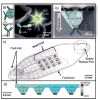Bioanalytical chemistry of cytokines--a review
- PMID: 25467452
- PMCID: PMC4717841
- DOI: 10.1016/j.aca.2014.10.009
Bioanalytical chemistry of cytokines--a review
Abstract
Cytokines are bioactive proteins produced by many different cells of the immune system. Due to their role in different inflammatory disease states and maintaining homeostasis, there is enormous clinical interest in the quantitation of cytokines. The typical standard methods for quantitation of cytokines are immunoassay-based techniques including enzyme-linked immusorbent assays (ELISA) and bead-based immunoassays read by either standard or modified flow cytometers. A review of recent developments in analytical methods for measurements of cytokine proteins is provided. This review briefly covers cytokine biology and the analysis challenges associated with measurement of these biomarker proteins for understanding both health and disease. New techniques applied to immunoassay-based assays are presented along with the uses of aptamers, electrochemistry, mass spectrometry, optical resonator-based methods. Methods used for elucidating the release of cytokines from single cells as well as in vivo collection methods are described.
Keywords: Aptamers; Cytokines; Immunoassay; Microfluidics; Optical resonators; Review.
Copyright © 2014 Elsevier B.V. All rights reserved.
Figures










Similar articles
-
A simplified cytokine immunoassay using magnetic polymer particles.Scand J Immunol. 2004 Sep;60(3):287-91. doi: 10.1111/j.0300-9475.2004.01484.x. Scand J Immunol. 2004. PMID: 15320886
-
Multiplexed fluorescent bead-based immunoassays for quantitation of human cytokines in serum and culture supernatants.Cytometry. 2001 Sep 1;45(1):27-36. doi: 10.1002/1097-0320(20010901)45:1<27::aid-cyto1141>3.0.co;2-i. Cytometry. 2001. PMID: 11598944
-
Detecting transforming growth factor-β release from liver cells using an aptasensor integrated with microfluidics.Anal Chem. 2014 Sep 2;86(17):8865-72. doi: 10.1021/ac502383e. Epub 2014 Aug 22. Anal Chem. 2014. PMID: 25105888 Free PMC article.
-
Advances in Proteomic Techniques for Cytokine Analysis: Focus on Melanoma Research.Int J Mol Sci. 2017 Dec 13;18(12):2697. doi: 10.3390/ijms18122697. Int J Mol Sci. 2017. PMID: 29236046 Free PMC article. Review.
-
A review on recent developments in optical and electrochemical aptamer-based assays for mycotoxins using advanced nanomaterials.Mikrochim Acta. 2019 Dec 7;187(1):29. doi: 10.1007/s00604-019-4034-0. Mikrochim Acta. 2019. PMID: 31813061 Review.
Cited by
-
Activation of STAT3 Regulates Reactive Astrogliosis and Neuronal Death Induced by AβO Neurotoxicity.Int J Mol Sci. 2020 Oct 10;21(20):7458. doi: 10.3390/ijms21207458. Int J Mol Sci. 2020. PMID: 33050466 Free PMC article.
-
Bacille Calmette-Guérin vaccine reprograms human neonatal lipid metabolism in vivo and in vitro.Cell Rep. 2022 May 3;39(5):110772. doi: 10.1016/j.celrep.2022.110772. Cell Rep. 2022. PMID: 35508141 Free PMC article.
-
A mechanistic integrative computational model of macrophage polarization: Implications in human pathophysiology.PLoS Comput Biol. 2019 Nov 18;15(11):e1007468. doi: 10.1371/journal.pcbi.1007468. eCollection 2019 Nov. PLoS Comput Biol. 2019. PMID: 31738746 Free PMC article.
-
Fabrication of nanofibrous mat surrounded hydrogel scaffold as an encapsulation device for encapsulating pancreas β cells.Sci Rep. 2022 Dec 19;12(1):21910. doi: 10.1038/s41598-022-25736-8. Sci Rep. 2022. PMID: 36535972 Free PMC article.
-
Plasma Levels and Diagnostic Utility of VEGF in a Three-Year Follow-Up of Patients with Breast Cancer.J Clin Med. 2021 Nov 22;10(22):5452. doi: 10.3390/jcm10225452. J Clin Med. 2021. PMID: 34830735 Free PMC article.
References
-
- Meager T. The Molecular Biology of Cytokines. New York: John Wiley & Sons; 1998.
-
- Thompson AW, Lotze MT. The Cytokine Handbook. 4. Amsterdam: Academic Press; 2003.
-
- Beschin A, Bilej M, Magez S, Lucas R, de BP. Functional convergence of invertebrate and vertebrate cytokine-like molecules based on a similar lectin-like activity. Springer-Verlag; 2004. pp. 145–63. - PubMed
Publication types
MeSH terms
Substances
Grants and funding
LinkOut - more resources
Full Text Sources
Other Literature Sources

